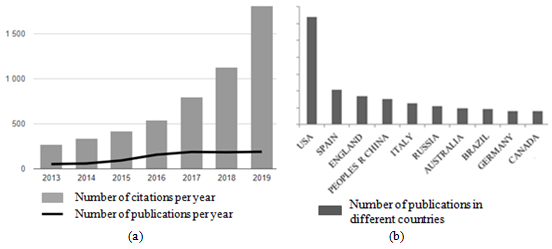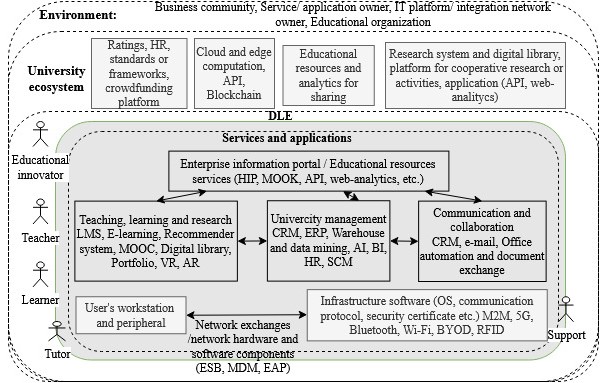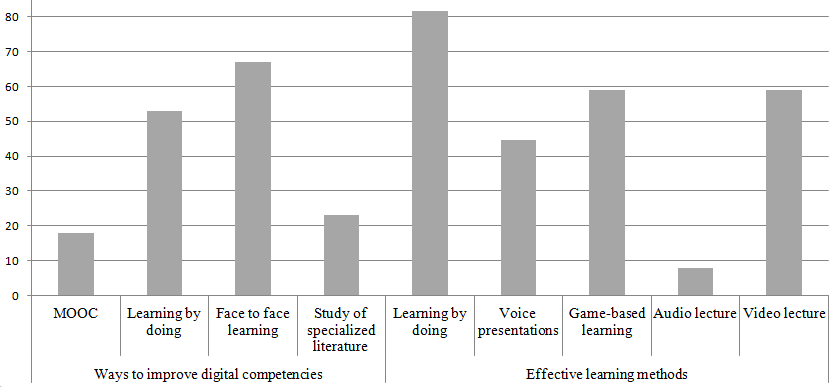Abstract
In this study, the authors proposed a model of the educational ecosystem, reflecting current trends in digital transformation. The described model of the educational ecosystem includes the types of actors of the university ecosystem and the external environment. Biotic and abiotic interactions occurring in the physical and digital space are divided into symbiotic, competitive and parasitic ones. There are proposed the most promising technologies, software and services for the selected types of interactions. These technologies can contribute to the effective transition of universities to a higher level of digital transformation. The model of digital educational environment (DLE) architecture, based on a service-oriented approach (SOA) is proposed. The applied part of this article presents the results of assessing the actors’ readiness in educational process to use the DLE tools at present. We conducted the online survey to identify students' preferences and their self-assessment of working skills in a digital environment. The online testing made it possible to assess the ability for communication in a digital area, skills of making digital content, providing digital security, solving problems in a digital environment. As a result, we found out in which areas actors are most prepared for digital interaction. In the research is revealed whether there are “significant” gender differences, and whether the chosen “field of study” (technical, humanitarian, economic) affects the level of digital competencies.
Keywords: Digital competencesDLE architectureuniversity ecosystem
Introduction
The Digital transformation of the educational system is an essential part of building a digital economy and an ecosystem of innovations. The transformation is now associated with the digitalization of existing educational content, workflow and the provision of high-speed internet access opportunities to schools and universities. To ensure competitiveness, universities have to solve the urgent problem of the implementation of the smart-learning concept, and to achieve the 4-5 level of digital transformation (Fernández-Caramés & Fraga-Lamas, 2019; Kleiner, 2019; Richert et al., 2016). Development and maintenance of information technology and telecommunications infrastructure elements, applications and information technology procedures will facilitate the integration of higher education actors: research, educational, innovative, administrative departments of the university (Jeladze & Pata, 2018; Jeladze et al., 2018; Ozdemir et al., 2018).
Problem Statement
The models of university governance and administration as well as learning strategies ought to change. At the same time, learners should be able to interact in “on-campus learning” and e-learning, to choose educational content based on individual needs. Relevant and full information on the services and support should be available to all actors, as well as technologies used for education.
Relevant and full information on the services and support should be available to all actors, as well as technologies used for education. Digital technologies, especially on-line, make education available to a wider range of persons. Such technologies allow higher education actors (HEAs) to continue the learning process through quarantine, forced temporary migration and part-time employment.
On the other hand, there are concerns about online education. For example, according to (BestColleges, 2019), 23% of American student respondents still doubt the quality of education and academic support of this form. Among the problems, 17% of the respondents note the lack of communication and interaction with professors and other students. 18% of them are not sure that potential employers will accept the results of e-learning as equally as with full-time education.
The Russian study revealed that 36% of respondents have a negative attitude toward this form of education. As a weakness, they noted a lack of personal contact between learners and teachers, less efficiency and lack of control and motivation for learners. Limited opportunities for students to access technologies outside the university (for example, in (Davis, 2020) this problem was noted by 42.5% of respondents), a lack of time to master new technologies (ibid., 39.4%), few alternative MOOC and digitized programs are barriers to efficient digital learning.
The reasons impeding the transition to digital solutions are: a large number of various technologies and gadgets used in working with students; the weak participation of external actors in the practical manual's development and their audit; the limited standards and technological support; the lack of statistics on the effectiveness of technological solutions in practice.
If we evaluate the attitude to digital technologies in Russia, we can note that more than half of the population consider themselves poorly informed about modern technologies. The positive connotations are mainly associated with the introduction of “smart” technologies in various fields (NAFI, 2019).
The issues of setting educational goals and filling academic content and applied technologies are extremely important in conditions of total digitalization and a high level of uncertainty. We consider the concept of the ecosystem as the most relevant model for training specialists in the new digital economy (Adner, 2017; Falkner et al., 2018). The ecosystem of universities is defined as a complex of internal and external actors in the education environment, and all synchronous and asynchronous interactions (symbiotic, competitive and parasitic) between them occurring in the physical and digital space, and providing a quick response to external and internal changes (Dragunova et al., 2018).
Interest in the topic of “ecosystem of universities” is rising. There are joint publications by researchers from different countries. Figures 01a&b show the results of a bibliometric analysis of publications indexed in the Web of Science Core Collection on this topic, reflecting the dynamics of the number of publications and citations from 2013 to 2019, and visualizing the distribution of publication numbers by country.

This study presents the architecture of the educational ecosystem, including its digital part, and describes the types of interaction between the main actors.
Research Questions
For the purpose of solving the research goal, the following research question was defined:
What types of biotic, abiotic components are typical to university ecosystems?
What DLE architecture can ensure the efficient interaction of biotic and abiotic components?
Are the HEAs ready to work in the ecosystem of the university, including DLE?
Purpose of the Study
The purpose of this study is to assess the readiness of key actors of the higher education system in synchronous and asynchronouss interaction in the context of digitalization.
Research Methods
The study is based on the concept of ecosystem building. The bibliometric analysis presents the dynamics of interest in this topic. Online surveys and Internet-testing are used to determine the level of digital competencies of ecosystem actors.
Findings
Building an ecosystem model of the educational environment: types of actors and interaction
The university ecosystem is subject to the requirements of flexibility, quick reaction to internal and external changes, maintaining a multitude of horizontal connections and communications, globality and the highest efficiency. The external contour of the university ecosystem is understood as a system of successful connections between the university and the business community. The multi-component internal environment includes an ecosystem for students, teachers and staff, as well as the administrative and managerial staff of the university. According to Põldoja (2016), the university ecosystem includes several levels of biotic and abiotic components (Table
The “Environment” level includes a description of an ecosystem context. These are external actors with which the university interacts in the physical and digital space (5G, IoT, Web2.0 Web4.0 e.t.c), conditions determining the goals of its development, the tools to achieve them. At this level, restrictions on ecosystem resources, membership in a particular group, and potential behaviour strategy are determined. For example, universities with high ranking positions can potentially rely on additional funding, which helps to develop their ecosystem by employing research specialists, opening new laboratories, and gaining access to unique databases and knowledge. These improvements will attract more able students from different levels of education and funding from other sources. Conclusively, there is a “crowding out” or “absorption” of weaker competitors in the ecosystem. Within an Environment, several ecosystems can coexist. However, they don't necessarily compete with each other. At the “Community” level, associations of educational organizations are formed (consortia of universities¸ networking). The beneficial forms of collaboration between universities and schools (contests, competitions, popular lectures, sports and athletics competitions), business (organization of internships, basic departments) are determined. A significant form of interaction is the “symbiosis” of students and trainees (expert and professional communities, platform owners and integrators, boards of trustees). At the “Habitat” level, there are particular architectural solutions for educational organizations that provide the ability to collect and analyze data on the educational process, development and relationship management (LMS, social networks, messengers). These systems should be appropriately integrated and configured to provide information for making effective management decisions (Advising system, Data warehouse and data mining) and obtain “useful mutations” to adapt to a changing environment. The “Niche” level includes various actors who interact with each other in the physical space, as well as using digital devices (BYOD), specialized applications and technologies (LMS, Assessment and Recommender systems, MDM, VDI), and broadband Internet (4G, 5G ).
Digital learning Environment
In the education domain the term digital learning ecosystem is usually cited to understand e-learning infrastructure and implementation of new learning tools. To realize the stated goals and interactions between actors, ecosystem components through pedagogical techniques, management practices and information technologies are combined into a Digital Learning Environment (DLE). Today, the development prospects of DLE are associated with service-oriented architecture (SOA). The Figure

Modern universities that are willing to compete on a global scale have a dual-task. They have to train specialists who can successfully work in the digital environment and economy as well as provide students with modern digital services throughout the educational process, and identify how learners are ready to use them. The actual “hard, soft and digital” competences of students have to form as a result of the efficient functioning of the learning ecosystem. Digital competence is a combination of knowledge, skills and attitudes, through technology, to perform tasks, solve problems, communicate, manage information, collaborate create and share content effectively, appropriately, securely, critically, creatively, independently and ethically (Dragunova et al., 2018). Digital competence has 5 levels (spheres): information literacy; communication and collaboration; creation of digital content; digital security; and problem solving (Carretero et al., 2017).
Assessment of readiness of actors to interact in the ecosystem of the university, including DLE
We tried to find out in which areas the actors are most prepared for digital interaction, whether there are “significant” gender differences, and also whether the chosen “field of study” affects the level of digital competencies. As a part of the study, we conducted an online survey identifying students' preferences and their self-assessment of digital work skills and online testing assessing digital content creation skills, digital security, problem-solving skills in a digital environment and the ability to communicate in a digital environment.
Students of 1, 2 undergraduate courses in technical, social and economics participated in Internet-testing. Characteristics of respondents: 58% – male, 42% – female; 60% - first-year students, 40% - second-year students; educational domain: 60% – technical science; 24% – social science; 16% – economics. Table
There is a high percentage (45%) of social respondents with “below average” and “low” values in terms of “Digital security” and 30% of economists with “Digital content skills” problems (Table
The online survey involved first-year students – 39%, fourth-year students – 32%, graduate students – 13% and teachers – 16%. Based on the results, the following most frequent answers were identified:
The majority of students prefer smartphones as a digital device for learning and communication, while teachers prefer personal computers and laptops.
37% of students consider social networks to be the most popular source of information from new digital technologies; graduate students – blogs and specialized forums; teachers – digital media and social networks.
23% of respondents think that they can use specialized search tools and build search queries, 77% of them in most cases can independently find the needed information on the global network. All categories frequently use search tools, text and voice chats, e-mail.
There are differences in the regularity of using blogs (45% of teachers do not use blogs and 41% of first-year students regularly use blogs), video conference (44% of graduate students and 32% of teachers regularly use), computer games (first-year students frequently play – 25%) and Wiki – tools (33% of first-year students and graduate students use them, 40% of teachers almost do not use them).
All categories use mobile payments and order goods in online stores.
Answers to questions about the most effective ways to improve digital competencies and present training materials (ease of perception) are rather interesting (Figure

Conclusion
Current transformational processes provide proactive universities with unique opportunities to create new services in a digital environment that will help students to get the required competencies, knowledge and abilities and ensure the realization of individual learning paths. A “new” generation of learners (Z Generation and Alfa Generation) has appeared, there is a globalization of competition “for the learner”, training programs are becoming interdisciplinary, and the system for evaluating learning results is changing. To efficiently take advantage of opportunities and challenges, the ecosystem and the digital learning environment of the university must provide the availability of “active learning classes” equipped with high-speed Internet, interactive whiteboards, projectors, portable equipment, VR gadgets; the fast integration of various systems or creation of new applications using the API from different systems; transition to cloud technologies and creation of Mixed Data Centers (local and cloud); developing own MOOC and access to OER; ensuring equal access to technology for users with various types of disabilities; accessibility of student data analysis technologies: trends in student behaviour and identification of factors affecting their loyalty to an educational institution, academic performance, personal growth, and satisfaction with various services introduced.
References
- Adner, R. (2017). Ecosystem as Structure: An Actionable Construct for Strategy. Journal of Management, 43(1), 39-58.
- BestColleges. (2019). Online Education Trends Report. https://res.cloudinary.com/highereducation/image/upload/v1556050834/BestColleges.com/edutrends/2019-Online-Trends-in-Education-Report-BestColleges.pdf
- Carretero, S., Vuorikari, R., & Punie, Y. (2017). DigComp 2.1: The Digital Competence Framework for Citizens with eight proficiency levels and examples of use. JRC Working Papers, JRC106281.
- Davis, L. (2020). Digital Learning: What to Know in 2020 [Web log message]. https://www.schoology.com/blog/digital-learning
- Dragunova, E. V., Pustovalova, N. V., & Valdman, I. A. (2018). Innovative technologies in designing new learning ecosystems. In A. V. Gadyukina (Ed.), Proceedings of the 14th International scientific technical conference: Actual problems of electronic instrument engineering (pp. 358-364). NSTU. https://doi.org/10.1109/APEIE.2018.8545087
- Falkner, K., Vivian, R., & Williams, S. (2018). An ecosystem approach to teacher professional development within computer science. Computer Science Education, 28(4), 303-344. https://doi.org/
- Fernández-Caramés, T. M., & Fraga-Lamas, P. (2019). Towards Next Generation Teaching, Learning, and Context-aware Applications for Higher Education: A Review on Blockchain, IoT, Fog and Edge Computing Enabled Smart Campuses and Universities. Appl. Sci., 9(21), 4479. https://doi.org/10.3390/app9214479
- Garzon, J., & Acevedo, J. (2019). Meta-analysis of the impact of augmented reality on students’ learning gains. Educational Research Review, 27, 244-260.
- Grant, M. (2019). Difficulties in defining mobile learning: analysis, design characteristics, and implications. Education Tech Research & Development, 67, 361-388.
- Huang, T. C., Chen, C. C., & Chou, Y. W. (2016). Animating eco-education: To see, feel, and discover in an augmented reality-based experiential learning environment. Computers & Education, 96, 72-82.
- Jeladze, E., & Pata, K. (2018). Smart, Digitally Enhanced Learning Ecosystems: Bottlenecks to Sustainability in Georgia, Sustainability, 10(8), 2672.
- Jeladze, E., Pata, K., & Quaicoe, J. (2018). Factors determining digital learning ecosystem smartness in schools. Interaction Design and Architecture(s), 35, 1-21.
- Kleiner, G. B. (2019). University as an Ecosystem: Institutes of Interdisciplinary Management. Journal of Institutional Studies, 11(3), 54-63.
- NAFI. (2019). NAFI research center. https://nafi.ru/analytics
- Ozdemir, M., Sahin, C., Arcagok, S., & Demir, M. K. (2018). The effect of augmented reality applications in the learning process: A meta-analysis study. Eurasian Journal of Educational Research, 74, 165-186.
- Põldoja, H. (2016). The Structure and Components for the Open Education Ecosystem Constructive Design Research of Online Learning Tools (Doctoral dissertations). Aalto.
- Richert, A., Shehadeh, M., Willicks, F., & Jeschke, S. (2016). Digital Transformation of Engineering Education-Empirical Insights from Virtual Worlds and Human-Robot-Collaboration. International Journal of Engineering Pedagogy (iJEP), 6(4), 23-29. https://online-journals.org/index.php/i-jep/article/view/6023
Copyright information

This work is licensed under a Creative Commons Attribution-NonCommercial-NoDerivatives 4.0 International License.
About this article
Publication Date
27 May 2021
Article Doi
eBook ISBN
978-1-80296-107-2
Publisher
European Publisher
Volume
108
Print ISBN (optional)
-
Edition Number
1st Edition
Pages
1-1907
Subjects
Culture, communication, history, mediasphere, education, law
Cite this article as:
Dragunova, E., & Pustovalova, N. (2021). Assessing The Actors’ Readiness To Educational Cooperation In The Age Of Digitalization. In E. V. Toropova, E. F. Zhukova, S. A. Malenko, T. L. Kaminskaya, N. V. Salonikov, V. I. Makarov, A. V. Batulina, M. V. Zvyaglova, O. A. Fikhtner, & A. M. Grinev (Eds.), Man, Society, Communication, vol 108. European Proceedings of Social and Behavioural Sciences (pp. 1456-1465). European Publisher. https://doi.org/10.15405/epsbs.2021.05.02.185

